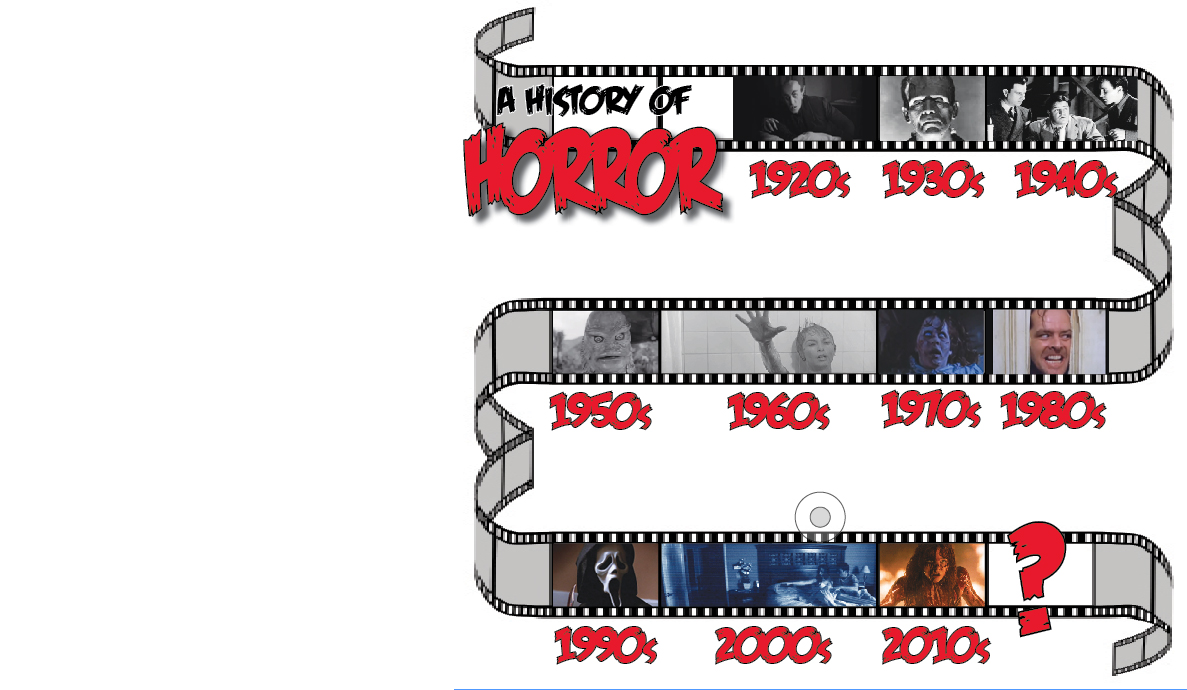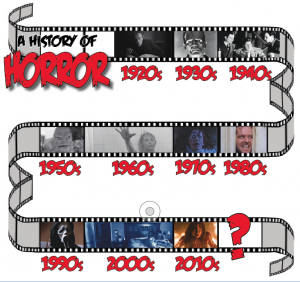The Halloween season, to me, is synonymous with monsters, eerie music and a just little bit of blood.
While countless horror fanatics pop in a classic for a good scare, I slowed down to examine why and how horror film changes from decade to decade. In my research, I discovered that the horror culture indirectly reflects the time and society in which it occurs.
In retrospect, it’s interesting to see how far society has come. From barely a drop of blood to seeing a human’s guts fall out, our culture feeds it and inadvertantly embraces the spooks and scares as they come.
1920s
Horror truly began for film in the 1920s. Without prior experience in this genre, an air of avant-garde and experimentation filled the screens with the majority of the films drawing plot lines from gothic literature.
Films like “Dr. Jekyll and Mr. Hyde (1920),” “Fall of the House of Usher (1928)” and the iconic “Nosferatu (1922, pictured)” all reflect the essence of the birth of horror film.
1930s
The 1930s aroused a new breed of scares: the conception of the movie monsters. With elements of romanticized horror, Universal Studios churned out classics like “Dracula” (1931) and “Frankenstein” (1931, pictured).
While Universal ran the market for scary flicks during this time, RKO Pictures produced outliers in the horror genre that are still iconic today, including the original “King Kong” (1933).
1940s
As the film industry started to reach momentum, so did the incline of World War II. The genre devolved in the 1940s as a result of the real-life horror happening around the world.
To lighten the theaters, the famously-funny duo Bud Abbott and Lou Costello created parody films spoofing the monster movies, including “Abbott and Costello Meet Frankenstein” (1948) and “Hold that Ghost” (1941, pictured).
1950s
Following the war, a new wave of horror fanatics were introduced to the drive-in movie experience.
This post-atomic bomb era recognized the impact of the teenage crowd and heavily catered to their tastes.
With this new and revived market, the ’50s welcomed iconic films like “Godzilla” (1954), “Attack of the 50-foot Woman” (1958), “The Blob” (1958) and “Creature from the Black Lagoon” (1954, pictured).
1960s
The culture of the 1960s blew up with turbulence and revolution as a result of the Vietnam War. In conjunction, this era saw a dawn of horror and depicted that the scariest aspects were unseen and left up to imagination.
Hitchcock’s “Psycho” (1960, pictured) was a major turning point which showed that a monster isn’t necessarily Frankenstein. Other films include “Rosemary’s Baby” (1968) and “Night of the Living Dead” (1968).
1970s
Although economically a bad time in society, this era was arguably the greatest decade of horror. While the genre consisted mostly low-budget independent films, they appeared socially in tune with the evolving times.
The first horror blockbuster, “The Exorcist” (1973, pictured), set a new standard and reevaluated the genre altogether. The first “Halloween” movie (1978) and “The Omen” (1976).
1980s
With the new and invogorating rise of this genre, the ’80s turned up the notch with gross-out and outlandish special effects. Excessive overkills and blood splatters highlighted the cult classics and slashers like “Evil Dead” (1981), “Nightmare on Elm Street” (1984).
Additionally, Stephen King’s horror novels became the stories people screamed for, as seen in “The Shining” (1980, pictured) and “Cujo” (1983).
1990s
A recovery phase in horror began in the 1990s with the advent of psychological thrillers. Notable works from this decade include “Silence of the Lambs” (1991), “Se7en” (1995) and “Interview with a Vampire” (1994).
Although Hollywood was pushing the mental horror scene, slashers still remained a prominent entity.
The most iconic from this decade was the first of the “Scream” series (1996, pictured).
2000s
The devastation of September 11 forced Americans to rethink what truly scares them. Horror evolved into situations that could actually happen, including viruses in “28 Days Later” or psychopaths in the “Saw” franchise (2003)
Although “The Blair Witch Project” (1999) caused a storm in the late ’90s, the found-footage element in horror exploded with the “Paranormal Activity” series (2007, pictured) and other demon possession films.
2010s
In only the three years in this decade, the horror genre has already morphed once again. At this point, remakes have overtaken the box office,such as “Carrie” (2013, pictured) and “Nightmare on Elm Street” (2010).
Television’s also taken a bite out of scare tactics. “American Horror Story” (2011) and “The Walking Dead” (2010) have both set the bar much higher for film. House invasion movies like “The Purge” (2013) are also adding to the genre.






